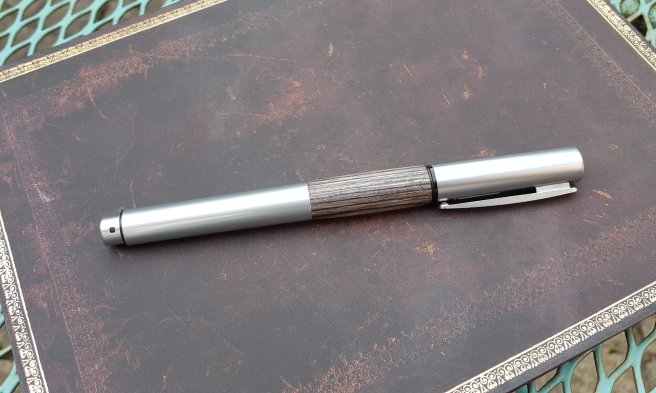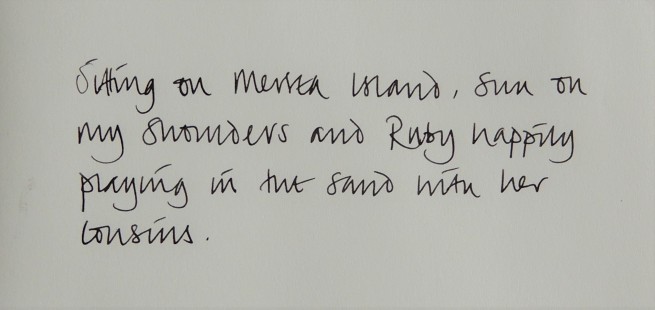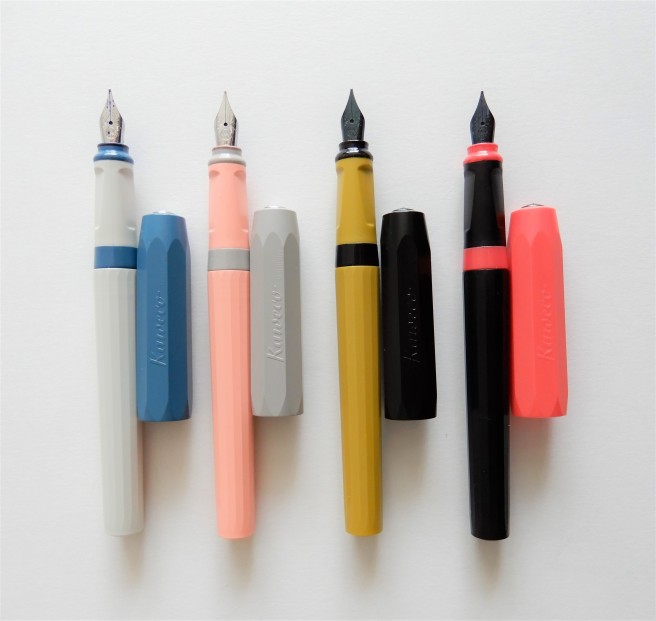Working within walking distance of a stationery shop is a bit of a hazard for the pen-prone. As a recent lunch hour indulgence, I treated myself to a new Lamy accent fountain pen from Rymans, one of the few bricks and mortar pen shops I know of which sells them.
I had seen the pen there before, but had never really given it a second glance. Uncapped, in the display cabinet, it was a bit odd-looking. However, I was intrigued by the wooden grip section and asked to see it. I was quite surprised at what I found.
Design and construction
This is a metal, cartridge/converter pen, with a short, screw cap. I think the barrel and cap material is aluminium, (possibly Palladium coated?). The pocket clip is sprung (and even has GERMANY engraved on a recess on the underside). The only visible branding is the name LAMY in small letters on the cap, alongside the top end of the clip. The cap sits flush with the barrel when the pen is closed but is also designed to be posted, on a little prominence to stay flush with the barrel. The cap posts securely, held on by two little black plastic lugs.
But the distinguishing feature of the pen, is the grip section, made of a grey coloured wood with a black irregular natural grain. It is also slightly curved and is wider in the middle than the two ends. Also, it can easily be removed and then swapped for a different material, such as a black rubber version although finding one might be a challenge.

According to Lamy’s web site, this is Karelia wood. However, this is not a tree I have heard of and so far I have been unable to find any reference online to a tree of this species although there are many references to a brand named Karelia Wood which specialises in engineered wood flooring.
The nib and filling system
The pen has the standard Lamy Safari stainless steel nib, and so is easy to replace or swap for other widths. But unlike the Safari this one has a black plastic mount, about 10mm long, between the nib and the wooden grip section.
You might be worrying that the lovely wood finish might get stained, the first time you dip it in an ink bottle. But no, to fill the pen, you remove the cap, hold the wooden grip section with one hand and then rotate the barrel with the other: this unscrews and releases the nib and feed unit which slowly starts to emerge out of the section, rather like a Graf von Faber Castell Intuition. Once removed, you only need to dip the nib unit in the ink, up to the black plastic mount and fill your converter in the usual way, and there is no risk to the woodwork if using bottled ink.

The pen was supplied with a Lamy converter and one blue Lamy cartridge. However I wanted to use a blue black Lamy cartridge which I had at home.
Weights and measurements
The pen is about 144 mm closed, 125mm open or a generous 163mm posted. Capped or posted it weighs about 26g, being 16g for the uncapped pen and 10g for the cap. This is quite a pleasant weight, having a bit of substance but not being overly weighty. I did not find it back heavy when posted, but then I generally hold my pens quite high up from the nib.
Writing performance
The nib will be familiar to anyone who has used a Lamy Safari (which is anyone), namely smooth but firm. Mine was a little on the stingy side in terms of ink flow, but acceptable. I found it to be wetter when writing “underarm” than when writing “overarm” (my left-handed slanting style with the back of the pen pointing away from me). I am used to finding that nibs are not so well lubricated this way.
I tried writing for an hour in a Paperchase notebook. I found the pen comfortable to hold when posted, being just slightly short for me if not. It was nice to have a wooden section to hold as this is rare in fountain pens.

But my blue black cartridge was producing a very pale line, given the rather dry nib and my light touch and very smooth paper. I later switched out the cartridge and put a black one in and this made a big improvement in readability.
Likes and dislikes
This is an unusual pen. If you enjoy the plain form and function of the Safari, then this makes a nice change and feels like an upgrade. Lamy does also make a version called the accent Brilliant with 14k nib, a glossy black lacquer barrel and polished briarwood collar, which looks like the dashboard material of an expensive car. I have not seen anyone with one of these pens, or even this Karelia wood version, come to think of it.
For those who bemoan the faceted grip section of the Lamy Safari and AL Star, here is a chance to use the same nib in a facet-free section. The wood is pleasant to hold.
However, I found that the black plastic rim of the cap is sharp and I could feel it rubbing on my hand as I wrote. I might try to smooth it down or round it off a little, if I can do so without ruining it.
Also, whilst I like screw caps, this one has one of the shortest travels that I have used, needing not quite half a turn to come off. However, once on, it does bite quite firmly and I have not had it come loose unintentionally as yet. Also I mostly carry pens in a leather pen case. The issue is remembering that it is a screw cap at one end and push on at the other.
Conclusion and Value
The shop price was £54.99, including the supplied converter and so similar in price to a Lamy Studio or Aion. I later found that it is currently £49.50 on Cult Pens, and they are also offering a further 10% off this and many other enthusiasts’ pens at the moment. But that is the difference that we pay to support our bricks and mortar stores and keep our High Streets alive!
It is a quite a special pen, well made and durable with unusual materials and for those who like the Lamy design ethos, it is an interesting addition to the collection.
Update: I have since smoothed the sharp edges of the black plastic cap rim. I pared them down to rounded edges with a knife and then smoothed and polished the rim by rubbing it on an envelope. This has resolved the issue.







